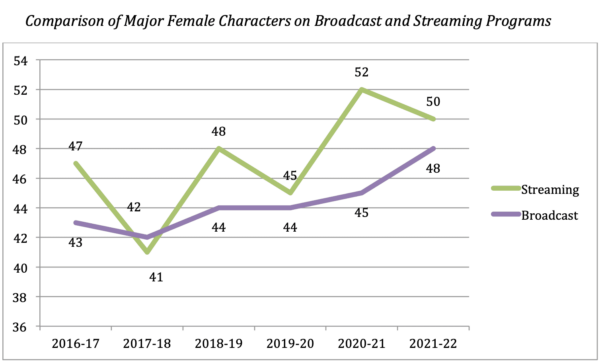Original programming on streaming services featured females as half of all its main characters, closely reflecting the proportion in the population at large, a report released Tuesday by San Diego State University researcher Martha Lauzen revealed.
Lauzen, executive director of the Center for the Study of Women in Television and Film at SDSU, released the 25th edition of the “Boxed In: Women On Screen and Behind the Scenes on Broadcast and Streaming Television in 2021-22” report, which tracks the gender and racial makeup of more than 3,000 TV characters.
The data found that females comprised 50% of major characters on streamed programs and 48% on broadcast network programs over the past year. Streaming programs also had a slightly higher percentage of female characters in speaking roles than broadcast programs at 47% compared to 45%.
“As they have for the last four years, streaming programs feature more major female characters than broadcast programs,” Lauzen said. “Half of the major characters on streaming programs are girls and women, approximating their numbers in the actual population.”
According to the research, broadcast network programs did have higher percentages of Black female (28%) and Latina (7%) characters in major roles than programs on streaming services — which were at 21% and 3%, respectively.
Streaming programs included a higher percentage of Asian and Asian American female characters than those on the broadcast networks — 15% compared to 10%.
Even with increasing gender and racial representation on television, increasing age still negatively correlates with screen time. At about age 40, female characters begin to disappear in substantial numbers from both broadcast and streaming programs, Lauzen found.
On broadcast programs, the percentage of major female characters decreased from 42% in their 30s to 15% in their 40s. Similarly, on streaming programs, the percentage of major females dropped from 33% in their 30s to 14% in their 40s.
“As women in the real world reach their 40s, they gain personal and professional power, yet it’s precisely at this age that the numbers of females dwindle on television and in film,” she said. “The majority of media images normalize regressive ideas about gender and age, valuing females for their youth and beauty and males for their accomplishments.”
Behind the camera, streaming programs employed higher percentages of women than broadcast network programs, with women comprising 37% of individuals working in key behind-the-scenes roles on streaming programs but 31% on broadcast network programs. Women comprised 29% of directors working on streaming programs but 18% on broadcast programs.
In 2021-22, “Boxed In” tracked more than 3,000 characters and 3,800 behind-the-scenes credits. Over the last 25 years — from 1997-98 to 2021-22 — the study has monitored more than 53,000 characters and 66,000 behind-the-scenes credits.







